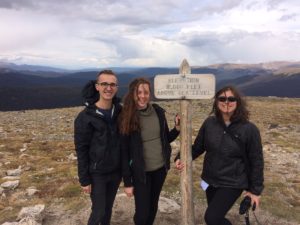* By Aida Cuni-Sanchez * Between the 17th to 20th September, the Pathways Conference 2017 took place at the Rocky Mountain National Park, in Colorado, USA. ‘Pathways to Success: Integrating Human Dimensions into Fish and Wildlife Management’ was an international gathering of over 270 scientists, NGOs, and government agencies, from 20 countries. The theme of the conference was FUTURES, addressing the myriad of issues that arise as people and wildlife struggle to coexist in a sustainable and healthy manner. Pathways 2017 was hosted by Colorado State University, in partnership with the US Fish and Wildlife Service in Rocky Mountain National Park.
Keynote speakers included Dan Ashe (President and CEO of the Association of Zoos and Aquariums), Joel Berger (Director of a number of projects for the Wildlife Conservation Society (WCS)) and Laurie Marker (Founder and Executive Director of the Cheetah Conservation Fund). The first speaker called for a more integrated approach to conservation. Such an approach recognizes the human dimensions of fish and wildlife management as the main focus of conservation, not just ‘the social aspect’ of it. The second speaker presented several WCS projects in cold and dry locations worldwide, including the successful story of the critically endangered saiga antelope (Saiga tatarica), for which recent surveys found more individuals than previously thought. He also spoke of the less successful story of other wild animals, which compete for pasture with a special breed of domestic goats. The number of these goats has dramatically increased the past few years, and thus associated conflicts, due to a growing demand of Pashmina products made with fine cashmere wool. The third speaker discussed the amazing story of the Cheetah Conservation Fund and its achievements in eastern and southern Africa. In addition to these captivating sessions, a session was organised in tribute to Dr Stephen Kellert (Professor Emeritus of Social Ecology at Yale and author of a number of books) called ‘Understanding the connections between humans and wildlife’. Several students of his former students presented their work, and many of his colleagues and friends attended. A week prior to the conference, the US Fish and Wildlife Service also organized training on the theme of the conference.

In the middle of the Rockies, the setting was perfect for discussing human-wildlife issues. Elk, mule deer and even wild turkeys roamed between buildings, day and night. Conference participants and tourists alike were amazed at these encounters, constantly taking pictures. The views from the conference room were stunning: aspen trees changing the colour of their leaves (from yellow, orange, to red) and the high mountains covered in snow, including the Longs’ Peak (over 4000m high!). The setting of the conference was slightly cold for the tropical and Mediterranean participants, but extremely beautiful.
Several social events were organised to promote networking: from a poster session with wine and cheese, to a barbecue with even marshmallow roasting (imagine!). We made new friends, discussed future projects and collaborations, and learned from one another. It was a packed few days, but incredibly fruitful. The next Pathways Conference and Training will take place Africa, in Windhoek, Namibia in January 8-11, 2018. Training will focus on community-based conservation and monitoring, education, human-wildlife conflict mitigation, communication, and more. Keep an eye on their website https://sites.warnercnr.colostate.edu/pathways-africa/. While the setting in Namibia will not be as mountainous, but I am sure it will be as interesting or more!

